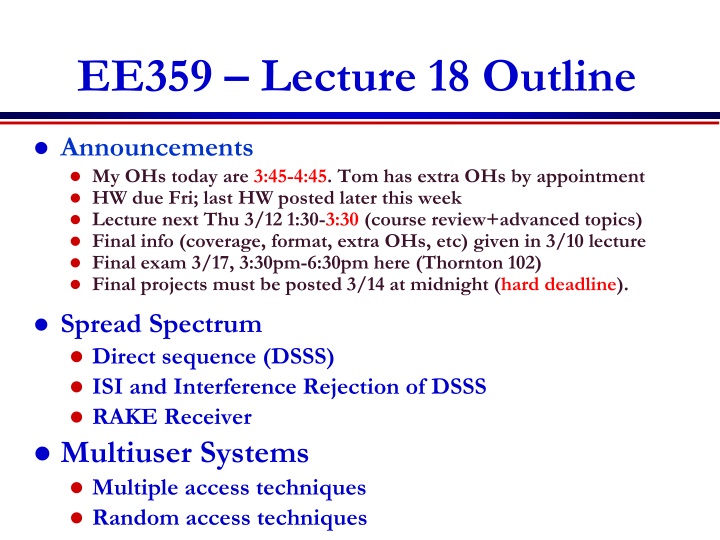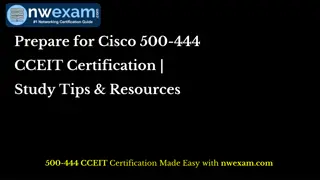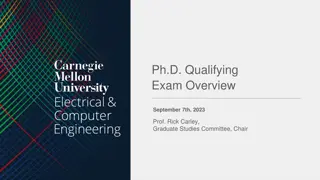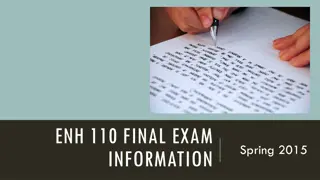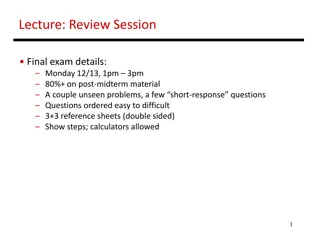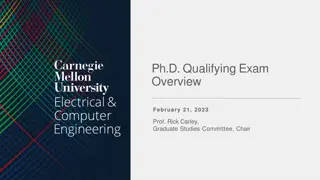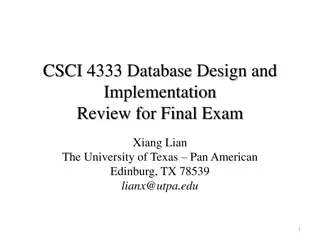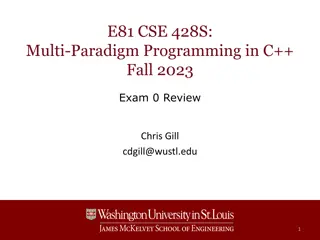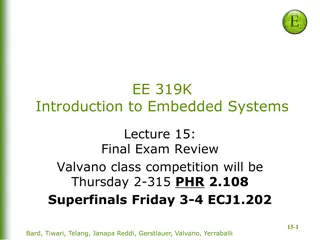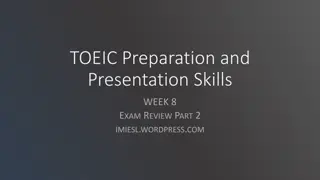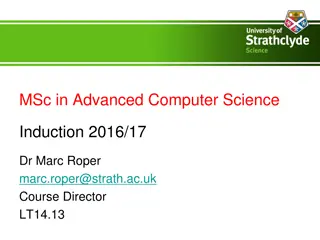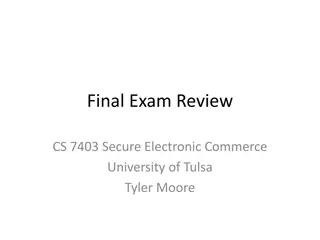Advanced Topics in Communication Systems: Lecture 18 Overview and Final Exam Details
In this lecture, we covered topics such as Spread Spectrum Modulation, Direct Sequence Spread Spectrum (DSSS), Interference Rejection, RAKE Receiver, and Multiuser Systems. The review of the previous lecture focused on OFDM design issues, including timing and frequency offset, peak-to-average power ratio (PAPR) considerations, and the application of MIMO-OFDM techniques. Important announcements regarding office hours, homework deadlines, and the final exam schedule were also highlighted. Exclusive details about the final exam format, coverage, and extra office hours will be provided in the upcoming lecture. The lecture slides and review materials are available for reference.
Download Presentation

Please find below an Image/Link to download the presentation.
The content on the website is provided AS IS for your information and personal use only. It may not be sold, licensed, or shared on other websites without obtaining consent from the author.If you encounter any issues during the download, it is possible that the publisher has removed the file from their server.
You are allowed to download the files provided on this website for personal or commercial use, subject to the condition that they are used lawfully. All files are the property of their respective owners.
The content on the website is provided AS IS for your information and personal use only. It may not be sold, licensed, or shared on other websites without obtaining consent from the author.
E N D
Presentation Transcript
EE359 Lecture 18 Outline Announcements My OHs today are 3:45-4:45. Tom has extra OHs by appointment HW due Fri; last HW posted later this week Lecture next Thu 3/12 1:30-3:30 (course review+advanced topics) Final info (coverage, format, extra OHs, etc) given in 3/10 lecture Final exam 3/17, 3:30pm-6:30pm here (Thornton 102) Final projects must be posted 3/14 at midnight (hard deadline). Spread Spectrum Direct sequence (DSSS) ISI and Interference Rejection of DSSS RAKE Receiver Multiuser Systems Multiple access techniques Random access techniques
Review of Last Lecture MCM, Overlapping Subcarriers and FFT Implementation (OFDM) MCM splits high rate data stream into lower rate flat-fading substreams Overlapping subcarriers reduces BW by factor of 2 Modulate symbols with IFFT at TX, Reverse structure (with FFT) in RX Cyclic prefix makes linear convolution of channel circular, so no interference between FFT blocks in RX processing X0 x0 n(t) TX R bps Add cyclic prefix and Parallel To Serial Convert Serial To Parallel Converter QAM Modulator x + h(t) D/A IFFT XN-1 xN-1 cos(2 fct) RX Y0 y0 Remove cyclic prefix and Serial to Parallel Convert R bps QAM Modulator Parallel To Serial Convert x LPF A/D FFT yN-1 YN-1 Yi=HiXi+ni cos(2 fct)
Review Continued OFDM Design Issues Timing/frequency offset: Impacts subcarrier orthogonality; self-interference Peak-to-Average Power Ratio (PAPR) Adding subcarrier signals creates large signal peaks Solve with clipping or PAPR-optimized coding Different fading across subcarriers Mitigate by precoding (fading inversion), adaptive modulation over frequency, and coding across subcarriers MIMO-OFDM Apply OFDM across each spatial dimension Can adapt across space, time, and frequency MIMO-OFDM represented by a matrix, extends matrix representation of OFDM alone (considered in HW)
Intro. to Spread Spectrum Modulation that increases signal bandwidth Spreads modulated signal over wider BW B~1/Ts than needed for transmission (R=log2(M)/Ts) Mitigates or coherently combines ISI Mitigates narrowband interference/jamming Hides signal below noise (DSSS) or makes it hard to track (FH) Also used as a multiple access technique Two types Frequency Hopping: Narrowband signal hopped over wide bandwidth Direction Sequence: Modulated signal multiplied by faster chip sequence
Direct Sequence Spread Spectrum Bit sequence modulated by chip sequence S(f) s(t) sc(t) Sc(f) S(f)*Sc(f) 1/Tb 1/Tc Tc Tb=KTc Spreads bandwidth by large factor (G) 2 Despread by multiplying by sc(t) again (sc(t)=1) Mitigates ISI and narrowband interference
ISI and Interference Rejection Narrowband Interference Rejection (1/K) S(f) I(f) S(f) S(f)*Sc(f) I(f)*Sc(f) Despread Signal Receiver Input Info. Signal Multipath Rejection (Autocorrelation ( ( ) )) ) S(f) S(f)*Sc(f)[ (t)+ (t- )] S(f) S (f) Despread Signal Receiver Input Info. Signal Can coherently combine all multipath components via a RAKE receiver
RAKE Receiver Multibranch receiver Branches synchronized to different MP components x sc(t) y(t) Demod ^ dk Diversity Combiner x Demod sc(t-iTc) x Demod sc(t-NTc) These components can be coherently combined Use SC, MRC, or EGC
Multiuser Channels: Uplink and Downlink Uplink (Multiple Access Channel or MAC): Many Transmitters to One Receiver. R3 x h3(t) x h22(t) x h21(t) Downlink (Broadcast Channel or BC): One Transmitter to Many Receivers. x h1(t) R2 R1 Uplink and Downlink typically duplexed in time or frequency Full-duplex radios are being considered for 5G systems
Bandwidth Sharing in Multiple Access Channels assigned by central controller Code Space Frequency Division OFDMA Non-orthogonal FD Time Frequency Code Space Time Division Non-orthogonal TD Time Frequency Code Space Code Division Code cross-correlation dictates interference Multiuser Detection Time Frequency Space Division (SDMA) Hybrid Schemes 7C29822.033-Cimini-9/97
Random vs. Multiple Access In multiple access, channels are assigned by a centralized controller - Requires a central controller and control channel - Inefficient for short and/or infrequent data transmissions In random access, users access channel randomly when they have data to send A simple random access scheme will be explored in homework ALOHA Schemes (not on exams/HW) Data is packetized. Packets occupy a given time interval Pure ALOHA Slotted ALOHA same as ALOHA but with packet slotting send packet whenever data is available a collision occurs for any partial overlap of packets (nonorthogonal slots) packets sent during predefined timeslots A collision occurs when packets overlap, but there is no partial overlap of packets Packets received in error are retransmitted after random delay interval. Packets received in error are retransmitted after random delay interval (avoids subsequent collisions).
Main Points Spread spectrum increases signal bandwidth above that required for information transmission Benefits of spread spectrum: ISI/narrowband interference rejection by spreading gain Also used as a multiuser/multiple access technique Multiple access: users can share the same spectrum via time/frequency/code/space division Random access more efficient than multiple access for short/infrequent data transmission
